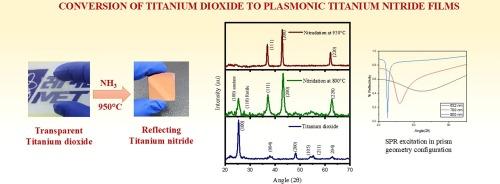Enhanced plasmonic performance of TiO2 derived TiN films via gas nitridation
IF 3.9
3区 材料科学
Q2 MATERIALS SCIENCE, MULTIDISCIPLINARY
引用次数: 0
Abstract
This study demonstrates a cost-effective method for planar titanium nitride plasmonic film by nitriding spin-coated TiO2 in ammonia atmosphere. The effect of nitridation temperature on the structural, morphological, electrical and optical characteristics of the coated films were investigated. The films exhibited high carrier concentration of 1022/cc with significant reduction in resistivity of more than three order of magnitude, indicating the conversion to the nitride phase. Negative permittivity, crucial for plasmonic applications in the visible wavelength region, was verified for wavelengths > 463 nm using Drude-Lorentz model. A three-layer model was employed to verify the material’s plasmonic behaviour. The straightforward fabrication route, which combines spin-coating and ammonia nitridation at 950 °C, offers a new approach for titanium nitride films for plasmonic based gas and biosensing device applications in the visible region. In addition, for fabricating titanium nitride coatings for applications that require abrasion resistance, electrical conductivity, chemical stability, and biocompatibility.

通过气体氮化提高 TiO2 衍生 TiN 薄膜的等离子性能
本研究展示了一种在氨气环境中通过氮化旋涂二氧化钛制备平面氮化钛等离子体薄膜的经济有效的方法。研究了氮化温度对镀膜的结构、形态、电学和光学特性的影响。薄膜的载流子浓度高达 1022/cc,电阻率显著降低了三个数量级以上,这表明薄膜已转化为氮化物相。负介电常数对可见光波长区域的等离子应用至关重要,利用 Drude-Lorentz 模型验证了波长为 463 nm 的负介电常数。采用三层模型验证了材料的等离子特性。这种直接的制备方法结合了旋涂和在 950 ℃ 下进行氨氮氮化,为氮化钛薄膜在可见光区域应用于基于等离子体的气体和生物传感设备提供了一种新方法。此外,它还可用于制造氮化钛涂层,以满足对耐磨性、导电性、化学稳定性和生物相容性的要求。
本文章由计算机程序翻译,如有差异,请以英文原文为准。
求助全文
约1分钟内获得全文
求助全文
来源期刊

Materials Science and Engineering: B
工程技术-材料科学:综合
CiteScore
5.60
自引率
2.80%
发文量
481
审稿时长
3.5 months
期刊介绍:
The journal provides an international medium for the publication of theoretical and experimental studies and reviews related to the electronic, electrochemical, ionic, magnetic, optical, and biosensing properties of solid state materials in bulk, thin film and particulate forms. Papers dealing with synthesis, processing, characterization, structure, physical properties and computational aspects of nano-crystalline, crystalline, amorphous and glassy forms of ceramics, semiconductors, layered insertion compounds, low-dimensional compounds and systems, fast-ion conductors, polymers and dielectrics are viewed as suitable for publication. Articles focused on nano-structured aspects of these advanced solid-state materials will also be considered suitable.
 求助内容:
求助内容: 应助结果提醒方式:
应助结果提醒方式:


